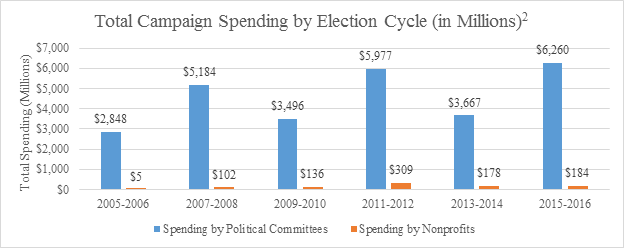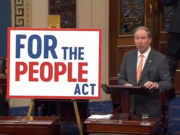A short while back, on Professor Rick Hasen’s invaluable listserv, there was a spirited discussion about the meaning of “dark money” as used in political debate. On the one side were those arguing that “dark money” was an almost infinitely malleable term used to obscure serious issues and deter meaningful debate and, on the other, those who insisted it had some real, discernible, concrete meaning.
Thus, today’s framing in Politico is interesting. The article illustrates the problem with the “dark money” hysteria gripping the journalistic and “reform” class.
At one point, author Tarini Parti quotes CCP President David Keating as saying that “dark money” has been blown out of proportion because it amounts to just five percent of political spending (the actual number appears to be more in the realm of four percent, even less in 2014, but five percent is a nice round number that gives the regulators some leeway). Parti then writes, “When asked by POLITICO to explain the 5 percent number, Keating said he was including only money spent by nonprofits directly advocating specific candidates and not issue ads that might criticize or praise candidates on a particular issue but don’t explicitly ask viewers to vote for or against them.”
In other words, Parti seems to think that five percent understates the number because it doesn’t count “issue ads” that may discuss or mention candidates, but don’t ask voters to vote for or against them. This is fascinating, because when supporters of more regulation complain about “dark money,” they’re pretty quick to throw out specific dollar and percentage figures, see, e.g., here or here. When the Brennan Center for Justice or the Center for Media & Democracy puts out a statement lambasting the Wisconsin Supreme Court as a bunch of unethical know-nothings for a recent campaign finance decision, is that intended to influence an election (the Wisconsin Supreme Court is elected), or is it just “issue speech”? No one knows. The definition one seems to get, from the listserv discussion, is that spending that is “intended to influence an election” is “dark money” (if it otherwise meets the criteria of not itemizing donors to the group making the expenditure); spending that is not so intended is not. Unfortunately, that simply raises more issues than it clarifies. (CCP actually calculates the percentage of dark money by using the figures of the Center for Responsive Politics and other “reform” organizations re: how much dark money is spent, and dividing it by total political spending reported by the same organizations or the FEC. It’s not really that hard. (Ms. Parti, by the way, used to work for the Center for Responsive Politics, so she must know how they calculate their numbers for “dark money,” or at least would be able to find out.)
If, however, we’re going to include issue advocacy in the numerator, then several things flow:
-
- We should begin calling most “reform” organizations, and indeed thousands of nonprofits all over the country, “dark money groups;”
- We must be sure to include non-express advocacy speech in the denominator as well as the numerator – this rarely seems to be done;
- We should make clear to citizens that most nonprofits in America probably qualify as “dark money” groups, including most groups to which they themselves belong;
- When discussing the “explosion” of “dark money,” we should compare apples to apples – that is, if discussion of issues and candidates that falls short of express advocacy is “dark money” today, then it was “dark money” ten, twenty, fifty, and 100 years ago. And if that is the case, no one has made any serious effort to determine if “dark money” has at all increased as a percentage of total political spending (defining “political” in this broad fashion); and
- If the test is a fact and intent based test into whether the speaker “intended to influence an election,” then we have the same Constitutional vagueness problem that led the Supreme Court to narrow the meaning of the “purpose of influencing an election” language in the Federal Election Campaign Act to “express advocacy” in Buckley. The anti-speech forces tend to be fine with vagueness, because they do want to restrict or discourage speech – at least some speech – and vague laws serve that purpose very well, as Buckley recognized.
What should be clear is that the very label “dark money,” whether it can be adequately defined or not, is intended as a pejorative to skew the difficult discussion about political speech and participation, government power, and the influence of money and wealthy donors. It’s handy and catchy, so it sticks, but it is not, and is not intended to be, a neutral description. And its definition is indeed malleable, so that the merry regulators can use it as they please. When they think a number sounds scary, they use it, as if “dark money” were some clearly defined and measurable concept. When their own numbers are turned back on them (as in pointing out that it is a very small part of total spending), “dark money” again becomes a vague concept, in which no one can know what is lurking below the surface, like some malevolent iceberg or killer shark.
In either case, “dark money” is a term used not to enlighten, but to scare Americans into approving of sweeping new laws, invading privacy in ways never before seen in American politics, and giving enormous authority to state regulators to pry into Americans’ political lives and create, as desired, lists of enemies and targets for government attack.














